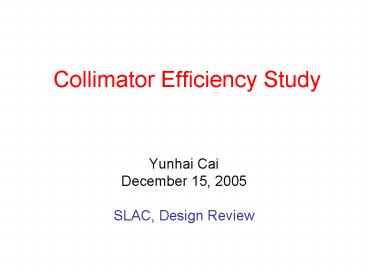Collimator Efficiency Study - PowerPoint PPT Presentation
1 / 18
Title:
Collimator Efficiency Study
Description:
73/144446 = 5x10-4. Tertiary halo at large amplitude. is generated by the large-angle ... Tertiary Halo Efficiency. Efficiency is down from 6x10-4 to 4x10-4 at ... – PowerPoint PPT presentation
Number of Views:26
Avg rating:3.0/5.0
Title: Collimator Efficiency Study
1
Collimator Efficiency Study
- Yunhai Cai
- December 15, 2005
- SLAC, Design Review
2
Betatron Collimators in IR7
3
Definition of EfficiencyRalphs
For a given normalized aperture ac, the
efficiency is
- N is of particles impacting at the collimators
- H(x) is the Heaviside step function
Please note once a particle reaches the aperture
ac in any turns, it is counted. Each particle
only is counted one or zero.
4
Multiple Coulomb Scattering
core 98
tail 2 up to 1.0x10-4
Fermi distribution (core)
Simulation core rms 2.49x10-6 with a cut
1.0x10-5. Theory core rms 2.53x10-6
5
Copper as the Material of Secondary Collimators
for Phase-II
- Collision energy 7 Tev and collision lattice
- Primary collimators at 6s and secondary ones at
7s. - Initial beam 6.003(0.0015) in vertical plane
- nx64.31, ny59.32,
- exey0.5nm-rad
- Simulated using code SixtrackwColl updated and
supported by Guillaume Robert-Demolaize at CERN
6
Study of Material for Secondary Collimators
Heavy material is more effective in terms of
efficiency of the system. So copper is chosen
because its high thermal conductivity.
Length should be about 1 meter. Achievable
efficiency is about 3.5x10-4 at 10 s.
Copper
Similar result was obtained by Ralph Abmann
7
Loss Maps at Collimators
The difference Is mostly in the
primary collimators.
144,446 123,004
3000x64192,000 particles tracked in the
simulation.
8
Efficiency as Function of Aperture
At which aperture? What is the aperture of the SC
magnets?
9
Leak out from Secondary Collimators
smaller by 70m
For 15cm of interaction length of copper, 2
leakage gives an effective length of 60cm
compared with the actual length of 100cm. That
implies that there are significant
protons scattered through the edge of the
collimators due to the angular divergence.
Total number of proton leaked out is 1155 out of
144,446 absorbed.
10
How Particles Escaped Collimation System?
Horizontal Vertical
Route to large aperture
Secondary Tertiary
11
Vertical Skew Collimators
Secondary halo in normalized phase space at the
end of collimation system
Primary collimator
Collimators are projected to The end of
collimation system
This is an independent check of the simulation
code, since the collimators are plotted according
to the lattice functions calculated using MAD.
12
Tertiary Halo Particles Escaped from the
Secondary Collimators
TCSG.E5R7.B1 last skew collimator
Number of particles beyond 10s is 73, which is
consistent with the efficiency calculation 73/144
446 5x10-4. Tertiary halo at large
amplitude is generated by the large-angle Coulomb
scattering in the last collimator. If we add a
tertiary collimator at 8s in the same phase
as the collimator TCSG.D4L7.B1 after the
secondary collimators, the efficiency should be
better than 1x10-4.
TCSG.D4L7.B1
13
Important Components Contributed to the
Efficiency of Collimation System
- Leakage from the secondary collimator
- interaction length of collimator
- angular divergence, a, b functions
- Large-angle Coulomb scattering in the last
collimator - add tertiary collimator
- use W for the last collimator
14
Add One Tertiary Collimator(8s) at the End of
Collimation System
Tertiary Halo
Efficiency
Efficiency is down from 6x10-4 to 4x10-4 at 10s.
It can be improved further if a better phase is
chosen.
15
Efficiency of 60-cm Primary Collimators and
100-cm Carbon Secondary Collimators
Phase-I configuration
We see more escaped particles in the horizontal
plane. The efficiency in the vertical plane is
5E-4.
16
Efficiency of 60-cm Primary Collimators and
100-cm Copper Secondary Collimators
Phase-II configuration
Efficiency 2.5E-4 in all three directions based
on the simulation.
17
60-cm Primary Carbon Collimators
Loss map in the vertical plane used by Lew in his
calculation of energy deposition.
18
Conclusion
- With many help from our CERN colleagues, we have
locally established a simulation capability to
support the engineering design - We start to understand the main features in the
two-stage collimation system and have developed
useful ideas to improve its efficiency - Main improvement of the phase-II copper
collimator will be in the horizontal plane by
more than a factor of two































